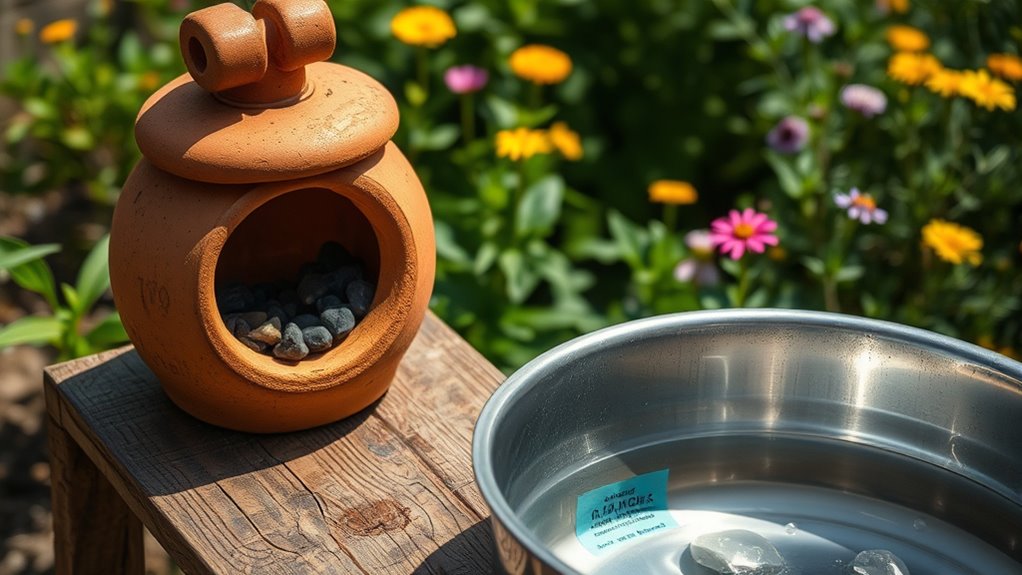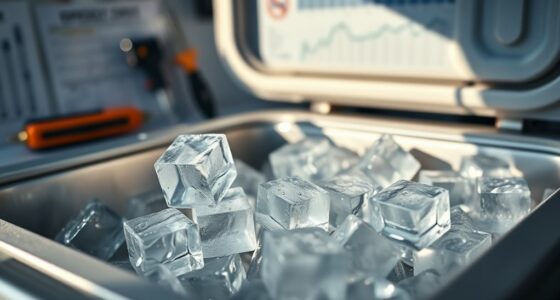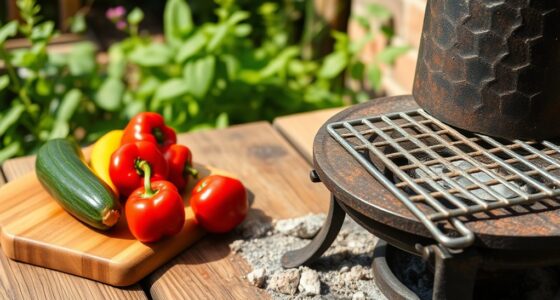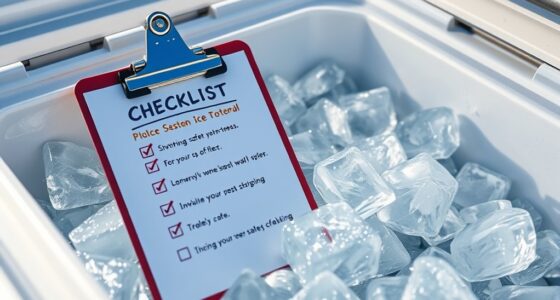To purify water without electricity, you can use proven methods like solar distillation and clay filtration. Solar distillation uses sunlight to evaporate contaminated water and collect the clean vapor, removing salts and chemicals. Clay filters trap sediments, bacteria, and parasites when water passes through layered porous material. Combining both techniques offers a simple, affordable way to guarantee safe drinking water in off-grid or emergency situations. Keep exploring to discover how to adapt these methods for your needs.
Key Takeaways
- Solar distillation uses sunlight to evaporate and condense water, removing pathogens, salts, and chemicals without electricity.
- Clay filtration involves porous clay combined with natural materials like charcoal and sand to trap sediments and microorganisms.
- Combining solar distillation and clay filtration provides comprehensive purification, addressing both dissolved contaminants and pathogens.
- Both methods are simple, inexpensive, and scalable, suitable for emergency, off-grid, or resource-limited situations.
- These techniques rely on readily available materials and natural energy, ensuring safe drinking water without electrical power.
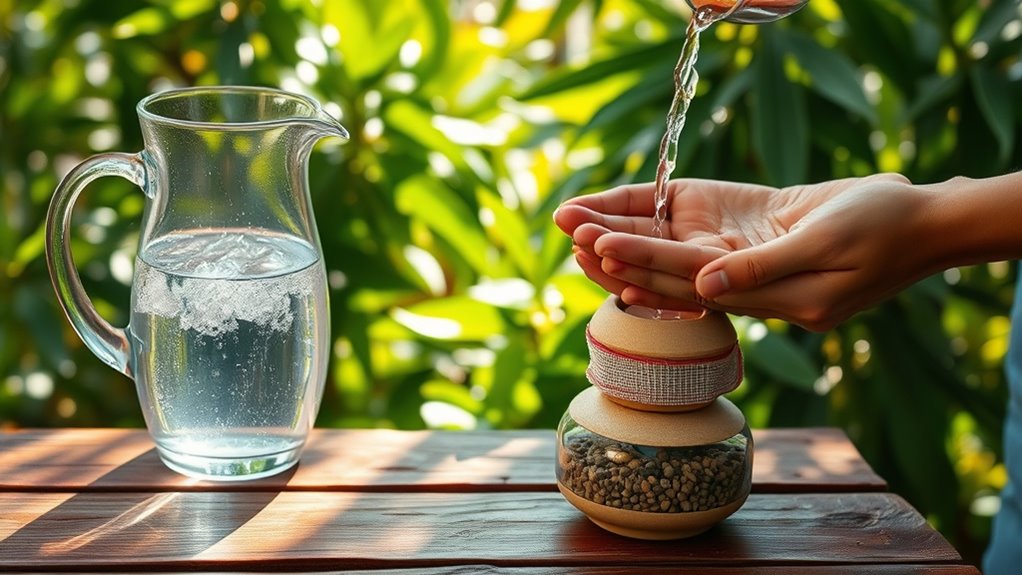
When electricity isn’t available, you can still effectively purify water using simple, proven methods. Two effective techniques are solar distillation and clay filtration, both reliable for removing contaminants and making water safe to drink. These methods don’t depend on power sources, making them ideal for off-grid situations, emergencies, or survival scenarios.
Solar distillation harnesses the sun’s energy to purify water naturally. You start by filling a shallow container with contaminated water, then cover it with a clear plastic sheet. Place a small weight or stone in the center of the sheet to create a dip, causing the condensed vapor to collect at the lowest point. As the sun heats the water, it evaporates, leaving impurities behind, and the vapor condenses on the plastic, dripping into a clean container. This process effectively removes pathogens, heavy metals, and salts, providing you with safe drinking water. It’s simple, inexpensive, and can be scaled up or down based on your needs, making it ideal for camping, emergency kits, or remote living.
Use solar distillation: cover contaminated water with plastic, create a dip, and collect evaporated, purified water.
Clay filtration offers another dependable approach. You create a filter by shaping clay into a porous form, often combined with natural materials like charcoal, sand, or gravel to enhance filtration. As water passes through the clay and other layers, sediments, bacteria, and many parasites are trapped, considerably improving water clarity and safety. Traditional clay filters are durable, reusable, and easy to produce using local materials, which makes them especially valuable in resource-limited settings. To use a clay filter effectively, pour contaminated water through it slowly, allowing the layers to do their work. Regular cleaning and maintenance extend the filter’s lifespan, ensuring continued effectiveness over time. When combined with boiling or chemical disinfection, clay filtration becomes even more reliable for safeguarding your health.
Both methods—solar distillation and clay filtration—offer practical solutions when electrical power isn’t an option. Solar distillation is particularly good at removing dissolved salts and chemicals, while clay filtration excels at reducing sediments and pathogens. When used together, they provide a thorough purification system that addresses a wide range of contaminants. Incorporating appropriate filtration techniques can further enhance water safety and quality. These techniques are simple to implement, don’t require complex equipment, and rely on readily available materials. They empower you to produce clean, safe drinking water regardless of your environment or resources, giving you peace of mind in challenging situations. By mastering these methods, you guarantee access to safe water without electricity, which is crucial for health, safety, and resilience.
Frequently Asked Questions
Can Natural Materials Improve Water Taste After Purification?
Yes, natural materials can improve water taste after purification. By adding natural additives like herbs, citrus peels, or activated charcoal, you enhance taste and aroma, making the water more invigorating. These natural options act as taste enhancers, removing any unwanted flavors and adding a pleasant, natural flavor. Incorporating these methods is simple, cost-effective, and eco-friendly, ensuring you enjoy clean, great-tasting water without relying on chemicals or electricity.
How Long Can Purified Water Be Stored Safely?
You can typically store purified water safely for about 6 months if you keep it in a clean, airtight container. However, the storage duration varies depending on factors like container material and storage conditions. Always check for contamination risks, such as cloudiness or foul odors, before use. To guarantee safety, consider revitalizing your stored water regularly and using proper storage techniques to prevent bacterial growth or recontamination.
Are There Any Health Risks With Traditional Purification Methods?
Yes, traditional purification methods can pose health risks if not done correctly. Poor filtration health may leave bacteria or viruses in the water, and boiling safety is essential to avoid burns or contaminating the water by recontamination afterward. Always guarantee you follow proper procedures, such as using clean containers and boiling water for at least one minute, to reduce risks and make your water safe to drink.
What Equipment Is Needed for Solar Water Disinfection?
You only need a few simple items for solar water disinfection. First, gather clear, plastic or glass bottles, as these are essential for effective UV exposure. You’ll also need a sunny spot to place the bottles where they can receive direct sunlight for at least six hours. Studies show this method reduces harmful pathogens by over 99%, making solar disinfection a reliable, eco-friendly option.
How Effective Are Homemade Filters Against Chemical Contaminants?
Homemade filters can be somewhat effective against chemical contaminants if you use chemical filtration methods like activated charcoal or specific resins. These DIY purifiers can reduce certain chemicals, odors, and some toxins, but they aren’t foolproof. For better safety, combine homemade purifiers with boiling or other methods. Remember, the effectiveness depends on the filter’s materials and how well you maintain and replace them regularly.
Conclusion
So, here’s the irony—you don’t need fancy gadgets or electricity to get clean water. Sometimes, the simplest methods, like boiling or using natural filters, do the trick perfectly. It’s almost amusing how we often overlook these tried-and-true techniques in favor of complex solutions. Next time, remember that your own hands and basic tools can provide safe water, proving that sometimes, the best solutions are the most straightforward—no power needed.
